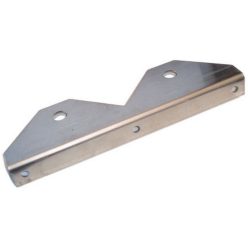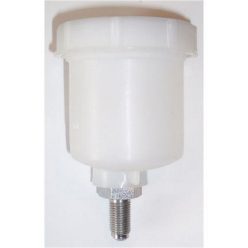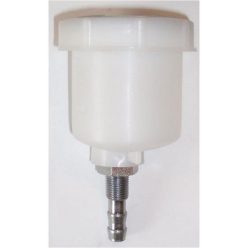Brake fluid reservoirs & accessories provide everything you need to feed and support hydraulic brake and clutch systems: universal and remote brake fluid reservoirs, mounting brackets, caps, vents, level-sensor options plus hoses and fittings. A correctly sized, well-mounted reservoir keeps a stable fluid level, prevents aeration and makes bleeding easier, whether you are running an OEM-style setup, a race bias system or a hydraulic handbrake on your drift car.
Net price: 16 €
Overview & Key Benefits
Brake fluid reservoirs & accessories cover the top end of the hydraulic system—the parts that store and supply fluid to your master cylinders. A properly chosen brake fluid reservoir ensures there is always enough fluid above the ports, avoids air ingestion and helps manage expansion and contraction as temperatures change. With the right combination of size, material and mounting position you can rebuild an OEM layout or design a fully custom motorsport brake and clutch system that remains consistent under heavy use.
Technical Basics
Modern brake fluid reservoirs are typically made from heat-resistant plastic or lightweight aluminium, formulated to cope with glycol-based DOT 3/4/5.1 fluids and high engine-bay temperatures. Lower outlets feed the master cylinder via hose barbs, threaded ports or AN fittings, depending on the design. Caps often include an integrated vent hole or membrane to equalise pressure while keeping dust and moisture out, and some OEM-style units offer level switches for warning lamps.
Larger reservoirs give you more fluid reserve, reducing the risk of uncovering the ports under heavy braking or pad wear, but they also take more space and may be harder to position cleanly. Remote-style systems place the reservoir on a bulkhead or strut tower and connect it to the master cylinder through short sections of brake-fluid-safe hose, improving packaging and sometimes making bleeding easier. For race cars with multiple master cylinders it is common to use separate reservoirs for each circuit to simplify diagnosis and keep systems independent.
Selection Criteria
When choosing a brake fluid reservoir, first define the application: OEM replacement, performance street upgrade, full race system or hydraulic handbrake feed. For daily drivers, a clear plastic reservoir with visible MIN/MAX markings is usually ideal, making level checks quick and simple. Track and drift cars often benefit from slightly larger capacity and robust aluminium reservoirs with strong mounting brackets, designed to cope with higher temperatures and vibration.
Pay attention to the connection type: the outlet(s) must match your existing hose size, master cylinder inlets or AN fittings. If you already run AN-3/AN-4 lines, using reservoirs with AN-compatible ports or proper adapters minimises the number of joints and potential leak points. Cap design also matters—a good cap combines positive sealing with effective venting so that fluid expansion and contraction does not create pressure or vacuum in the reservoir, while still resisting spillage under lateral g loads.
On clutch systems, compact reservoirs can make packaging easier, especially with engine swaps or tight bay layouts. Dual-chamber reservoirs that feed both brake and clutch circuits can save space but must be mounted so both sections remain visible and properly vented. Accessories such as mounting brackets, clamps, replacement caps, grommets, O-rings and vibration isolators help integrate the reservoir cleanly and securely into your build.
Installation & Maintenance
For installation, the most important rule is that the reservoir sits higher than the master cylinder inlets so gravity keeps the ports covered at all times. Mount the reservoir on a strong bracket or factory mounting point so it cannot move under hard braking or bumps. Route hoses with generous bends to avoid kinking, keep them away from hot components such as exhaust manifolds or turbochargers, and protect them with sleeving or spiral wrap wherever they pass close to sharp edges.
From a maintenance perspective, inspect fluid level and reservoir condition regularly. Look for discolouration, crazing or cracks in plastic bodies, and for signs of seepage at hose joints and fittings. A damaged or hardened hose, or a damp area around the outlet spigot, is a warning that replacement is due before a real leak develops. Check the cap seal and vent hole as well—if the vent is blocked, vacuum can form in the reservoir and cause a soft or sinking pedal as fluid struggles to flow.
Whenever you flush or upgrade brake fluid, it is worth cleaning or flushing the reservoir itself so sludge, water or debris are not carried into the rest of the system. Never mix incompatible fluid types, and always confirm that the reservoir material is suitable for the DOT rating you intend to use. On hard-driven track and drift cars it is good practice to inspect the entire reservoir–hose–fitting assembly at least once per season, as heat and vibration loads are far higher than on normal road cars.
FAQ
How big should my brake fluid reservoir be?
For normal road use, a reservoir similar in size to the OEM unit is usually sufficient. For track or drift cars a slightly larger fluid reserve provides extra safety margin as pads wear and temperatures rise, but there is no benefit in fitting a huge tank that is difficult to package.
Can one reservoir feed both brake and clutch circuits?
Yes, dual-chamber reservoirs can supply separate brake and clutch circuits, provided each section has its own outlet and minimum level. This saves space but you must mount and plumb the unit carefully so a failure in one circuit does not leave the other completely dry.
Which is better for my build: plastic or aluminium reservoir?
Quality plastic reservoirs are light, inexpensive and easy to read, making them ideal for most street and club-sport cars. Aluminium units are tougher and more heat resistant, which is useful in extreme motorsport environments, though you lose the convenience of transparent walls.
Do I need a vented cap on my reservoir?
Yes. A proper vent allows air to move in and out as the fluid expands and contracts, preventing pressure build-up or vacuum in the system. The vent should include a seal or membrane so it resists spillage and keeps dirt and moisture out.
What should I do if I see dampness around the hose connection?
Check that the clamp is correctly positioned and tightened, and inspect the hose for hardening or cracks. If the hose material has aged or the spigot is damaged, replace the affected parts rather than just tightening the clamp harder, which can actually worsen the leak.






